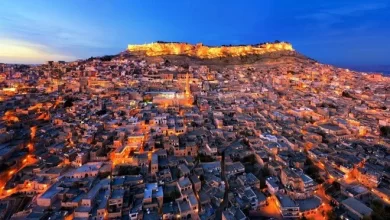White Beauty: Pamukkale Travertines

To talk about the endless beauties of nature; Turkey is one of the rare countries that hosts the most epic natural beauties of the world. The world-famous Pamukkale travertines stretch along the Menderes Valley with its thermal pools reminiscent of vast white cotton fields and its geological heritage. At the same time, these limestone white mountains are one of the most photogenic spots in Turkey and one of the most famous places in the country.

As if Pamukkale’s pure beauty and healing thermal waters were not enough, it shares this magnificent natural beauty with the Ancient City of Hierapolis. Let’s take a closer look at Pamukkale travertines, which were included in the UNESCO World Heritage List in 1988, and those who are curious about Pamukkale.
Where are Pamukkale Travertines?

Pamukkale travertines are located in Denizli province. Pamukkale, which is a short 18 kilometers away from Denizli Center, is very easy to reach from the city center.
Even when viewed from afar, this limestone plateau Pamukkale travertine offers a dazzling view to its visitors and is located 400 meters above sea level. travertines; It seems to float on a hazy surface of reality until its great whiteness sharpens in the details as it approaches. Snow-white stalactites and water rivets shimmer in the sun, while shallow pools of healing thermal water reflect the bright blue sky. Her beauty is so surprising and unexpected; Even the most tired traveler will forget all his tiredness when he goes there.

How Did Pamukkale Travertines Form?
Travertine is a type of rock. It is formed by precipitation as a result of chemical reaction depending on various reasons and environments. During these reactions, water supersaturated with calcium hydrocarbonate reaches the surface, carbon dioxide is gassed and the rest precipitates as carbon dioxide structures. The reaction continues until the carbon dioxide in the thermal water and the carbon dioxide in the atmosphere come into balance. At the same time, this reaction; It is also affected by ambient temperature, weather conditions and water flow.

General Information
Thermal waters literally make Pamukkale “Pamukkale” and thanks to a tectonic fault, these waters gush from an outlet in the plateau. For at least 14,000 years, calcium-rich water swelled from the depths of the earth, flowed across the earth and floated along the edges of high cliffs, gradually hardening to form a layer of white limestone. Influenced by weather conditions, these mineral deposits take fantastic shapes, creating large flat areas with the texture and appearance of 50-meter stalactite waterfalls, evenly stepped travertines, shallow leaf-shaped pools and snowy fields.

It is Forbidden to Enter With Shoes!
You may have noticed that there are mineral-rich turquoise waters on the hot spring terraces. This natural phenomenon has a breathtaking view and is also very sensitive to all kinds of external factors. Therefore, if you want to visit cs, you should take off your shoes and walk barefoot on a special road. Because this measure; It prevents the erosion of calcium deposits forming the terraces.







